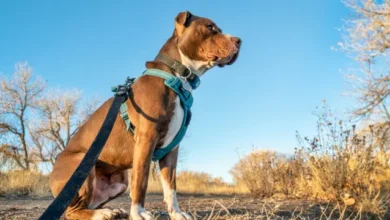
Understanding the Need for a Dog Harness
Choosing the best dog harness is a critical decision for any dog owner. Unlike a collar, a harness can distribute pressure more evenly across a dog’s torso, providing better control and reducing the risk of injury. However, the right choice depends on various factors, including your dog’s size, breed, and behavior, as well as your specific needs as an owner. Here, we’ll explore the most important considerations to make this decision easier.
Size and Fit
The first and most crucial factor in selecting a harness is ensuring it fits your dog properly. An overly tight harness can be uncomfortable and limit the dog’s range of motion, while an overly loose harness could let the dog escape. Use a flexible tape measure around the broadest part of your dog’s chest and the lower part of their neck to measure for the right size. Always refer to the manufacturer’s size chart to make sure you get the perfect fit.
You should be able to fit two fingers between your dog’s body and the harness when the harness is well-fitting. This ensures there is enough room for comfort without sacrificing security. Adjustable harnesses are often a good choice as they can be fine-tuned to better fit your dog.
Purpose and Activity Level
Consider what activities you will be doing with your dog. Are you planning on daily walks, hiking, running, or even water activities? Different activities require different types of harnesses. For example, a no-pull harness is ideal for training dogs that tend to tug on the leash, while a rugged harness with extra padding and durability might be better for hiking or long outdoor adventures.
The right harness can also accommodate extra features suitable for specific needs. Some come with reflective strips for nighttime visibility, while others offer attachment points for carrying small items or poop bags. Both you and your dog will benefit from meeting your unique demands with the appropriate harness features.
Material and Durability
The material of the harness can greatly affect its comfort and longevity. Nylon and polyester are common materials known for their durability and ease of cleaning. However, if your dog has sensitive skin, you might want to consider harnesses made from softer, padded materials to prevent chafing.
Always look for high-quality stitching and strong buckles, as these are the components most likely to wear out. A well-made harness may cost more upfront, but it can save you from frequent replacements and potential safety issues. Remember, your dog’s comfort and safety should always come first.
Ease of Use
Another important factor is ease of use. Some harnesses are designed to be slipped over the dog’s head, while others require the dog to step into them. Think about your dog’s temperament and your own convenience. If your dog is particularly energetic or difficult to manage, a step-in harness might be easier to put on and take off.
Quick-release buckles can also simplify the process of getting your dog in and out of the harness, saving you time and reducing stress for both you and your pet. Ultimately, the best harness is one that both you and your dog can use with minimal fuss.
Safety Features
Safety should always be at the forefront of your mind when choosing a dog harness. Reflective stripes or patches are invaluable for nighttime walks, ensuring that your dog is visible to passing cars. Additionally, some harnesses come equipped with a handle on the back, providing an extra level of control in situations where you need to grab your dog quickly.
A harness should also include strong, reliable attachment points for your leash. Double-check that the D-rings are securely attached to the harness and made from durable metal rather than plastic, which can easily break under strain. These features are essential to keep your dog safe in various conditions and environments.
Training and Behavior Considerations
Specialized harnesses can be beneficial if your dog is still in training or has behavioral issues like pulling or lunging. No-pull harnesses, for example, have a front-clip design that helps steer your dog back towards you when they try to pull ahead. This mechanism discourages pulling without putting strain on the dog’s neck.
Conversely, dogs that are naturally calm and well-behaved may not require such specialized designs. Instead, focus on comfort and durability to enhance their walking experience. Each dog is unique, and understanding their behavior can guide you to the most suitable harness.
Test and Adjust
Once you’ve selected a harness, testing it thoroughly before embarking on long walks or activities is important. Allow your dog to wear it around the house to ensure they are comfortable and that the harness stays securely in place. Make any necessary adjustments and observe how it performs under different conditions.
Regularly checking the harness for signs of wear and tear is also crucial. Even the best harness can deteriorate over time, and it’s better to replace it before it becomes a safety risk.
Conclusion
Choosing the right dog harness involves a balance of size, purpose, material, ease of use, safety features, and your dog’s specific needs. By considering these important factors and taking the time to find the best option, you can ensure your dog stays safe, comfortable, and happy during your walks and adventures together. A well-chosen harness is an investment in your dog’s health and your peace of mind.



